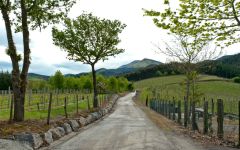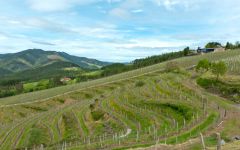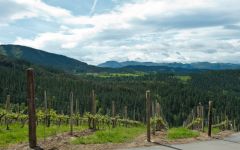Bodegas Berroja Berroia Txakoli 2011




Product Details
Your Rating
Somm Note
Winemaker Notes
Other Vintages
2021-
Wine
Enthusiast
-
James
Suckling
-
Wilfred
Wong
-
Robert
Parker
-
Robert
Parker






Bodegas Berroja founded in 2001 currently owns 37 acres (15 Ha) of vineyards in the town of Muxika , Bizkaia. Located in Zone 3 in the north of Spain between San Sebastian and Bilbao (Closer to Bilbao). Berroia is an estate-bottled wine made by Bodegas Berroja in the Txakoli de Bizcaia DO. Txakoli wines have a slightly “spritzy” effervescent character similar to vinho verdes from Portugal but whereas the latter are light wines with fresh, clean flavors and bright acidity, Txakolis have more complex aromas and depth of flavor on the palate along with a firm minerality that is their signature. The name Berroia refers to the area where the estate vineyards are located. Three Spanish DO regions in Spain produce Txakoli wines in the Basque country: Txakoli de Guetaria, Txakoli de Bizcaia and Txakoli de Alava. There are two Txakoli styles: a cider style and a still wine style. Both styles are made with the Hondarribi grape but one is more cider-like than the other. The still wine style shows the vibrancy and depth of the Hondarribi grape. The cider style has a life span of about 6 months while the still wine style develops for about 14-16 months. Berroia is made in the still wine style.
Photo Credit: Friederike Paetzold

White grapes are used in two famous types of Spanish wine, Sherry and Cava, but we will limit this discussion to still whites. Let’s begin with perhaps the best known and most highly regarded internationally, Albariño . Produced in the region of Rías Baixas, just above Portugal in northwestern Spain, Albariño typically sees no or little oak and is medium to medium-plus in body. Aroma and flavor notes often include citrus and peach, often with subtle floral notes and a suggestion of sea spray, giving the wine a zesty feel. Often bottled as a single varietal, Albariño is sometimes blended with other indigenous grapes like Loureira and Treixadura. Try one of these Spanish whites from Forjas del Salnes.
Let’s look at a few other Spanish white wines. Godello also hails from northwestern Spain and presents a profile of grapefruit, minerality and a slight smoky quality. Enjoy a bottle from Bodegas Avancia. The region of Rueda, northwest of Madrid, is home to Verdejo , which makes refreshing, un-oaked white wines whose herbal vibrancy recalls Sauvignon Blanc . Protos makes a tasty version. Up north in the Basque region, we find the wine called Txakoli (sometimes called Txakolina). Pronounced “sha-ko-LEE,” it’s made from a local grape called Hondurrabi Zuri and is light, fresh, citrusy, dry … and with razor sharp acidity that makes it a fantastic partner with local seafood and tapas. Ameztoi Gertariako is a good Spanish white wine producer to check out.
The Penedѐs region, best known for the oceans of delicious Cava it sends to the world, also produces still Spanish whites, sometimes from international varieties like Chardonnay , and often from the same grapes used for Cava. These include Parellada, Xarel-lo and Macabeo. Avaline produces a fine example of Penedes white. Finally, we visit the Rioja region. While it is historically and internationally famous for its reds, Rioja also produces fine Spanish white wines. These are usually based on Viura (the local name for Macabeo) and make good everyday sippers, although some aged versions can be stunningly complex. A good place to start is the white Rioja from Bodegas Muga.
As you can see, Spanish white wines offer a vast opportunity for exploration!
